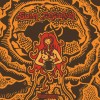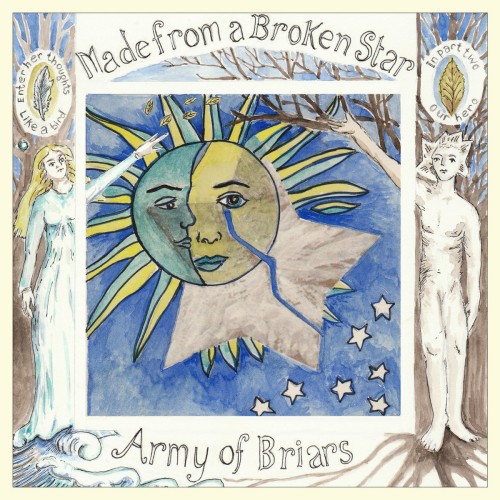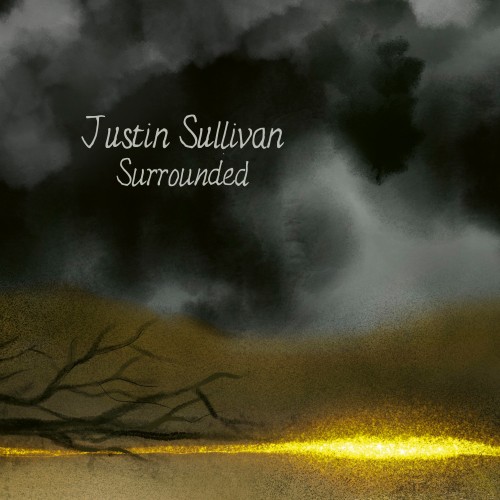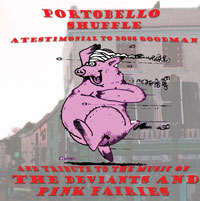Deep Distance (2LP)/Sulatron (CD)
 Sci-fi is the theme behind David Schmidt’s latest (re-)release as Sula Bassana. Even though part of this was originally available on CD, Deep Distance have done a marvellous job with the vinyl version. Not only do you get two different coloured discs (it’s a double album) but also Komet Lulu’s artwork looks absolutely gorgeous on 12” vinyl size and gives off the perfect visual representation to the cosmic soundtracks within.
Sci-fi is the theme behind David Schmidt’s latest (re-)release as Sula Bassana. Even though part of this was originally available on CD, Deep Distance have done a marvellous job with the vinyl version. Not only do you get two different coloured discs (it’s a double album) but also Komet Lulu’s artwork looks absolutely gorgeous on 12” vinyl size and gives off the perfect visual representation to the cosmic soundtracks within.
At points the sounds become ethereal, like early ’70s Zeit-era Tangerine Dream. On my second listen I played this over the opening 10 minutes of Vadim’s film and it actually went quite well with it. I get the distinct feeling though that, rather than make a soundtrack, Sula is trying to conjure up other images within the mind’s eye and using the name as a launch-off point.
“Thora” starts with low bass synth notes that have shimmering chord stabs over the top. Here we are adrift in a sea of shining stars where the pillars of creation are dead ahead and new solar systems are created. The almost robotic texture to the track as it progresses keeps the piece well centred in a kind of Seventies sci-fi feel and made me think of Jean-Claude Mezieres Valerian and Laureline graphics with its retro-future feel. The piece steadies into a more rhythm-extended workout that takes us on a ride through shining domed cities as we travel through glistening tunnels to our next destination.OK, where do I begin with “Stella Star” (track 1 side 2)? Based also on a space heroine, played by Caroline Munro in Luigi Cozzi’s 1978 science fiction epic released on the back of the then-current Star Wars craze for outer space movies. Often seen as a poor man’s cousin to George Lucas’s film, Starcrash still has many wonderful elements in it, not the least of these being a wonderful score by John Barry, Ms Munro’s outfits (what there is of them) and the first screen role of David Hasselhoff. With its convoluted plot and wonderful space battles, Starcrash is actually more of a true sci-fi film than Star Wars (which plays out like a western similar to Battle Beyond the Stars). Originally mooted as the first of three film adventures of Stella Star, sadly the others were not made.
Bassana takes us on a lilting cosmic voyage that catches Stella in the middle of her adventures. When the synths begin to head in take-off mode, we are taken into the heat of laser battle at the heart of another galaxy. The music gives a deep bass throb that wouldn’t be out of place on an Eat Static record as the track has more of an overall futuristic feel than a retro one. Again I watched part of the film using this as a soundtrack and found it worked perfectly alongside the more action-oriented sequences in the movie (of which there are plenty). “Stella Star” is cosmic dance music with the attitude of trance, but the underlying feel of disco band Space, that takes the characters journey to the outer regions of the cosmos.“Pygar” is the name of the blind angel from Forest’s Barbarella graphic novels. Sula here takes us more on a ethereal glide through the universe, conjuring musical images of Brian Eno’s ambient work, but especially late Seventies Tangerine Dream. Eerie Mellotrons hang in the air as string synth pads swell beneath them to give a luxurious feel of deep chill bliss. When the haunting guitar comes in, the piece transforms into a desert-scape melody more suited to Ray Bradbury’s Martian Chronicles. Echo guitar swells around the empty buildings of Mars, the inhabitants dead or long gone. “Pygar” takes us into the land of eyes-closed space travelling. It’s wonderful; just let it’s sounds wash right over you.
Disc two opens with “Trillian”, named after Zaphod Beeblebrox’s female companion in Douglas Adams‘s Hitchhikers Guide To The Galaxy. Here Sula treats us to more soaring synth pads as a rolling rhythm rides underneath to give an early morning trance feel to its vibe. Perhaps in reference to Marvin the Paranoid Android, synth notes scatter around and spiral downwards, their rhythm latching on to others buried beneath. This is inter-dimensional soundtrack music, this the drift after hyperspace, the blurring of star lines as they edge nearer to be swallowed by a black hole. “Space Taxi” is the shortest piece on the album and not part of the original release, and like the two other bonus tracks which follow, which appear only on the double LP. It feels more like Kraftwerk’s “Trans Europe Express” within its rhythmic components. It travels along as synths push the piece to give it its forward momentum, before the taxi picks up another passenger. “Wegbeam” is all glistening electronics that has a slight Arabic fugue played over the top. This gives it a feeling slightly more in the Vangelis range, as melodies dance whirling dervishes around each other. Here you are in a ancient summer garden in Egypt, smoke wafting around the carved pylons depicting the gods.Chirping cricket synth noises open “Gefuehlsknoten”, the final track on the album. Here we trip into The Infinity Projects‘ direction as the noises give way to blissed-out sequencer passages and hanging gardens of Babylon-style lead lines. As the sequencer grows more muddy, we head off worlds way (similar to the way Astropilot does with some of his work) and we are already above Earth’s atmosphere. This is Sula’s drift music piece and it works beautifully well whilst watching the planets move overhead in the early evening sky.
This is a stunningly wonderful album full of amazing contrasts. Deep Distance have only pressed 500 copies of this album worldwide so it would probably be wise to snap one up soon before they are all gone, and you too can indulge in your own personal Voyage dans la Lune.
-Gary Parsons-



